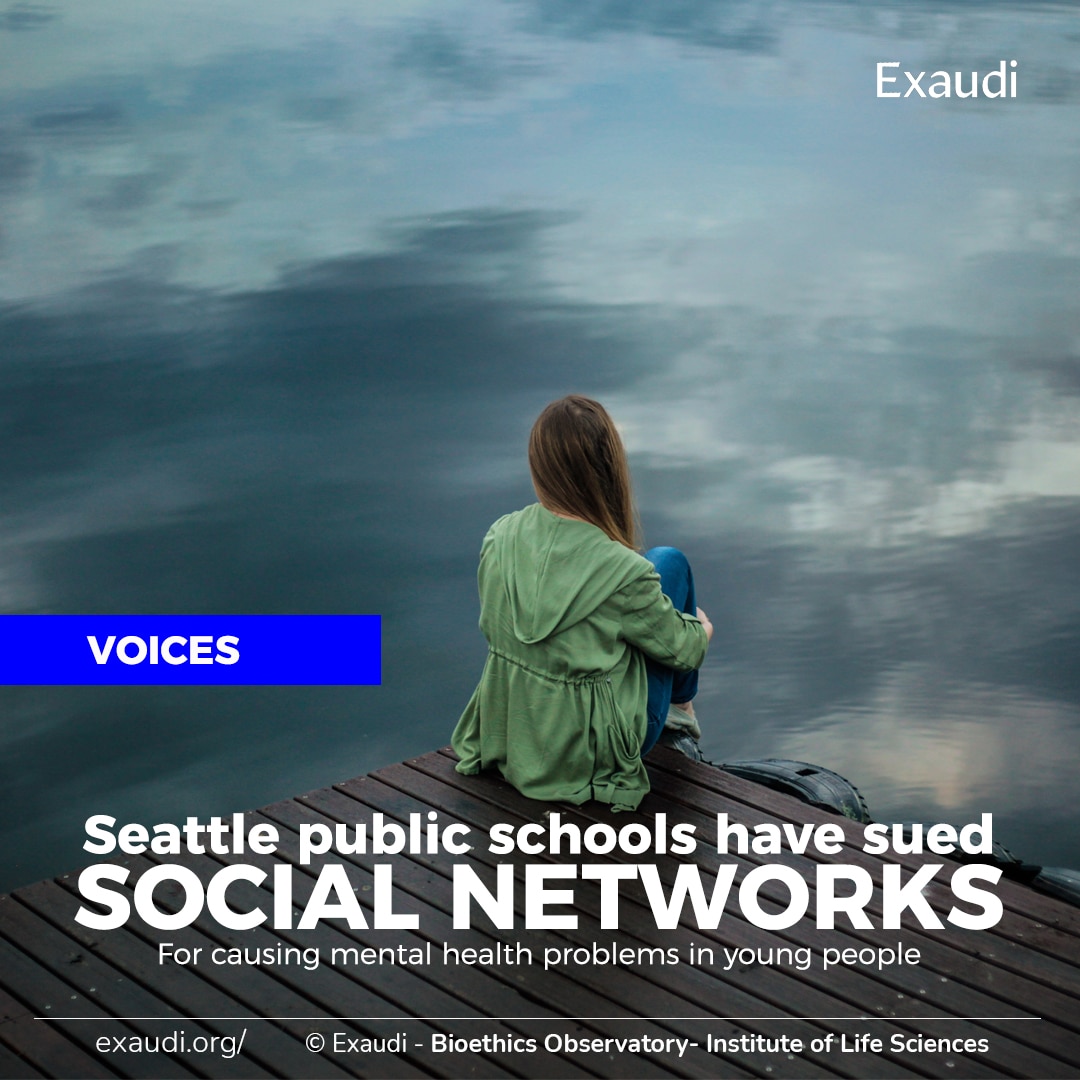According to BusinessInsider, Seattle school boards have blamed some social networks like Meta, TikTok, Google and Snapchat for manipulating and abusing the vulnerable brains of young people, «hooking tens of millions of students across the country into positive feedback loops of excessive use and abuse» of the aforementioned companies.
Specifically, they are accused of the deterioration in the mental health of young people, who could suffer from behavioral disorders such as anxiety, depression, eating disorders and cyberbullying.
In this way, the maturational progress of students is complicated and schools are forced to take action. Among them, the hiring of more mental health professionals, the development of study plans that work on the effects of social networks and the additional training of staff to deal with this situation.
Felicia Craick, an attorney of the firm that represents school districts states that “The increase in suicides, attempted suicides, and mental-health ER visits is no coincidence. As alleged in the complaint, this crisis was already growing before the pandemic and research has identified social media as playing a major role in causing mental health problems in youth”.
President Joe Biden has already called for social media platforms “We must hold social-media companies accountable for the experiment they are running on our children for profit.” In a Wall Street Journal column titled “Republicans and Democrats Unite Against Big Tech Abuses,” Biden implored both of America’s major political parties to unite to pass strong bipartisan legislation. This would serve to hold Big Tech accountable for these abuses they commit against the American people.
Scientific evidence
According to a research article published in the American Psychological Association (APA) “the percentage of young Americans experiencing certain types of mental health disorders has risen significantly over the past decade, with no corresponding increase in older adults”.
 Lead author of the study, Jean Twenge, professor of psychology at San Diego State University, believes that this trend may be partially due to increased use of electronic communication and digital media, which may have changed modes of social interaction enough to affect mood disorders. She also noted research shows that young people are not sleeping as much as they did in previous generations.
Lead author of the study, Jean Twenge, professor of psychology at San Diego State University, believes that this trend may be partially due to increased use of electronic communication and digital media, which may have changed modes of social interaction enough to affect mood disorders. She also noted research shows that young people are not sleeping as much as they did in previous generations.
In the aforementioned article, published in the Journal of Psychopathology and Clinical Science Twenge stated that “these trends are weak or non-existent among adults 26 years and over, suggesting a generational shift in mood disorders instead of an overall increase across all ages”.
“They looked at survey responses from more than 200,000 adolescents age 12 to 17 from 2005 to 2017, and almost 400,000 adults age 18 and over from 2008 to 2017. The rate of individuals reporting symptoms consistent with major depression in the last 12 months increased 52% in adolescents from 2005 to 2017 and 63% in young adults age 18 to 25 from 2009 to 2017. There was also a 71% increase in young adults experiencing serious psychological distress in the previous 30 days from 2008 to 2017. The rate of young adults with suicidal thoughts or other suicide-related outcomes increased 47% from 2008 to 2017.”
Changes in adolescents
A new research published in JAMA Pediatrics points to the changes that occur in adolescents who use social networks in an early way. One of the authors, Eva Telzer, stated that “the findings suggest that children who grow up checking social media more often are becoming hypersensitive to feedback from their peers.”
Other studies have shown that 78% of 13- to 17-year-olds report checking their mobile devices at least hourly; 35% of teens report using at least one of the top five social media platforms almost constantly.
“Most adolescents begin using technology and social media at one of the most important periods for brain development during our lifetime,” said co-author Mitch Prinstein and chief science officer for the American Psychological Association. “Our research demonstrates that checking behaviors on social media could have long-standing and important consequences for adolescents’ neural development, which is critical for parents and policy-makers to consider when understanding the benefits and potential harms associated with teen technology use.”
An increasingly addictive world
Paul Graham, one of the largest investors in Silicon Valley, has recognized that “the world is on track to become more addictive in the next 40 years than it has been in the last 40; think about how TikTok is hooking your kids more than Facebook ever did. And now imagine what TikTok will be like in the metaverse… All the factors that invade our attention are going to become more powerful.”
Several recent scientific studies have confirmed that adolescents are already incapable of dedicating themselves to the same task for more than 65 seconds, while adults can barely focus on a single task for three minutes. The cascade of emails, tweets, memes, alerts, stories and emoticons that rain down on us day after day is softening our brains and rendering them useless to undertake complex intellectual tasks.
Nature warns in a new study led by Kevin Madore and Anthony Wagner, psychologists at Stanford University in California, that the arsenal of screens we often use at the same time may be affecting our attention span and memory.
Bioethical assessment
Along with the scientific evidence that links abusive exposure to screens with psychiatric disorders related to mood states, we found a worrying low perception of associated risk among those responsible for educating children and young people, parents, and teachers. In addition, there is a negligent attitude on the part of the regulatory bodies and companies involved, which use virtual communication as a productive source of income and an effective means of manipulating individuals, creating trends, lavishing ideologies or simply distracting those who use them.
perception of associated risk among those responsible for educating children and young people, parents, and teachers. In addition, there is a negligent attitude on the part of the regulatory bodies and companies involved, which use virtual communication as a productive source of income and an effective means of manipulating individuals, creating trends, lavishing ideologies or simply distracting those who use them.
The risks for children and adolescents would be high suicide rates, low attention span, addictive behaviors, or developmental disorders. Even the dysfunctions derived from the sedentary lifestyle that it causes or vision problems.
The normalization of the abuse of electronic media for recreational purposes facilitates the spread of its undesirable effects among the population (children, adolescents, and adults), who end up incorporating them into their daily lives as the main element that hijacks their attention most of the time.
For many people, it constitutes the predominant way of communication with others, but it also greatly facilitates access to information with a high addictive risk, such as that related to gambling and betting, pornography, substance abuse, eating disorders (anorexia and bulimia), etc.
Therefore, in addition to facilitating access to electronic media, we must add the lack of control both in the time of use and in the content accessed. We must bear in mind that smartphones are the major gift for children aged 7 and over and that children and adolescents from 8 to 17 years of age spend an average of 3 hours a day hooked on social networks.
The supervision of minors is not the exclusive responsibility of the companies that promote social networks, nor even of the regulatory bodies, but rather, ultimately, constitutes an unavoidable duty of parents and educators.
They should be responsible for ensuring the appropriateness of both the use of electronic devices and the content accessed, which can contribute to seriously distorting the maturational process and, ultimately, the health and future of those affected.
It is necessary, more than ever, a training and information work aimed at parents, educators and managers of social media, which should promote their awareness of the incalculable risks to which users who abuse electronic media are exposed. Healthier and more balanced alternatives should also be encouraged, such as the diversification of stimuli, the promotion of real social relations instead of virtual ones, reading, sports, life in the open air or traditional games.
In conclusion, it is about recovering the connection with “the real world”, rich in its diversity of stimuli, which is much better suited to the needs of the evolutionary development of our brains, with a frequency and intensity much less than that of the social media. The maturational requirements of the brain include beauty, order and the dosage of stimuli, which also includes spaces of silence and solitude, much reviled today.
Julio Tudela and Cristina Castillo
Bioethics Observatory- Institute of Life Sciences
Catholic University of Valencia











